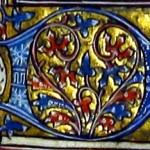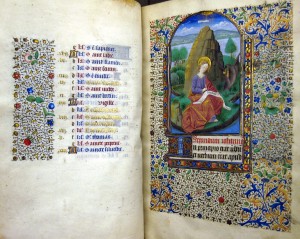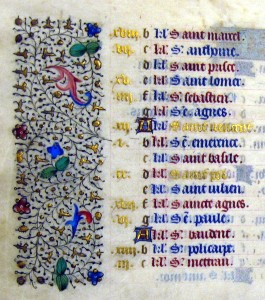 [Posted by Scott Gwara, English department, University of South Carolina]
[Posted by Scott Gwara, English department, University of South Carolina]
Part 1: a medieval kalendar (that’s no mis-spelling)
I have been spending the past few years traveling all over the US reading medieval manuscripts. I estimate that I have seen and handled 2500 of them so far, in perhaps 70 collections. I have a few research goals—probably too many—but chief among them is an inchoate, mammoth project, A History of Medieval Manuscripts in North America. That’s what brought me to Boston recently. I spent most of my time at Harvard, but I enjoyed a stop at Trinity (and Smith). You have fabulous manuscripts. I wanted to offer a little irregular series of notes on them. This collection represents a special treasure in the Watkinson Library, fascinating, valuable, and immensely useful for teaching History of the Book. My advice: take Professor Elukin’s book history course this Fall! How many times will you get to handle and study YOUR medieval treasures? You will never regret this decision: the experience will stay with you for a lifetime.
Having spent four solid days in the Houghton Library at Harvard, I was ready for the adventure of a smaller library. Harvard’s Richardson Collection is simply stunning but it is fairly well mined. You’re not going to find many surprises there, though I was honestly blown away by the intelligent way the collection was assembled: pure Harvard. William King Richardson came from Boston money, attended Harvard (class of 1880) and took a second BA at Oxford, graduating in 1883. He wanted to a PhD in Classics at Harvard, but you have to belong to the indigent classes to become a teacher, and Will was clearly unfit, despite a double first at Oxford (thanks to his Harvard preparation). The family money was well spent on 54 manuscripts and thousands of early printed books (over 100 incunables) and fine bindings. The manuscripts are nearly all complete texts, with fine bindings, wide white margins, and lovely illumination. They include a Wycliffite Bible in Middle English, a “heretical” bible with a furtive reputation. The last one that sold a year ago went for $2 million. Impressive to me was MS Richardson 16, an Italian manuscript on the art of war, Tacitus’ De instruendis aciebus. Great illuminations in gold and colors showing how to arrange phalanxes. Unfortunately, none of the online images shows these amazing diagrams.
By contrast, Trinity is just the place to find an overlooked treasure … like MS 8, an exquisite Paris Book of Hours. A Book of Hours is a prayer book. It’s called a Book of Hours because the key text is the “Hours of the Virgin,” basically a selection of Psalms (usually three of them) and related utterances recited at eight “hours” of the day. The eight hours are Matins, Lauds, Prime, Terce, Sext, None, Vespers, and Compline. Sometimes a Book of Hours is called a Horae. The Latin word for hour is hora, a first-declension (feminine) noun with an –ae plural. So, Horae = “Hours” or “Book of Hours.” I know it sounds weird, especially to a Latinist. But it is a horae, pronounced hor-eye.
Let me share a few things with you about this amazing manuscript in the short time I have.
The first thing I saw upon opening the book was a Paris kalendar (spelled with a k-), which is (typically, for a Paris kalendar) completely FULL of names. All feasts in a medieval kalendar are in the genitive case. They say, “of St. Thomas” rather than “St. Thomas” because the word “feast” is implied: “feast … of St. Thomas.” Have a look at the list of feasts: can you see how they alternate red and blue, with an occasional gold entry?

Most kalendars are graded: more important saints have feasts in different colors. Some can be quadruple-graded, four colors indicating a subtle importance for certain special feast days. Now, don’t be fooled: you can’t just count the colors (blue, red, gold) and say, “this is triple-graded.” Execute this test first. Look at Christmas, indicated here by the four gold lines on the left (try not to be distracted by the gorgeous illumination of St. John on the right):
So … Christmas is gold (not easily readable because the gold is still as bright as the day it was applied). Christmas is a major feast, so gold is, in this instance, the highest grade. Therefore, any feast in gold receives extra attention in the liturgy. (NB: sometimes gold is not the highest grade.) Now examine how the colors are ordered. Are they grouped randomly or do they vary red-blue-red-blue-red-blue, and so on?
Clearly, a kalendar doesn’t usually alternate important with less-important saints. This layout is decorative. Ergo, this calendar, for all its splendid pomp, is double-graded. If you want to check for a further Paris connection, look for St. Geneviève, patron saint of Paris (d. 512). Her Feast falls on 3 January. I don’t have a picture of this, but I’m willing to bet it’s in gold.
A few more details about kalendars in Books of Hours. Have a look at this kalendar from a fragmentary Trinity manuscript:
Question: how is it graded, and what color is the highest grade? Look at Christmas:
Okay, it’s a bit dirty and stained, but you can see these feasts are RED: Nativity, St. Stephen Protomartyr, St. John the Apostle, and Holy Innocents. Correct answer is “double-graded.”
However, THIS kalendar has some skipped dates. It’s not entirely full. We can often discover where a fragmentary Book of Hours comes from by looking at the unusual saints venerated on specific dates. You see, many saints were pretty local. St Peter would be venerated throughout Europe, but St. Osmund is uniquely English, and pretty much associated with York. The place to go for the information is the online Grotefend:
http://www.manuscripta-mediaevalia.de/gaeste/grotefend/grotefend.htm
Just look at all the saints listed in this resource. If we ever wanted to narrow down our search for a specific saint, this is the starting point. It’s easy and fun. Isn’t this manuscript fragment simply amazing? All Trinity owns is the kalendar and a few text leaves, but they’re so useful and make a wonderful exercise for localizing saints. So that’s all for now on kalendars.
Next installment: illuminations from MS 8. You’ll want to see these. They are unbelievably beautiful. For now, however, I will simply leave you with a taste of the sublime … Gabriel at the Annunciation unfurls a scroll with the words “Ave gratia plena,” while God the Father (got cut off at top) sends down the Holy Spirit (a dove) at the Incarnation. This is one of the most beautiful illuminations I have ever seen.
Tags: Visiting scholar




